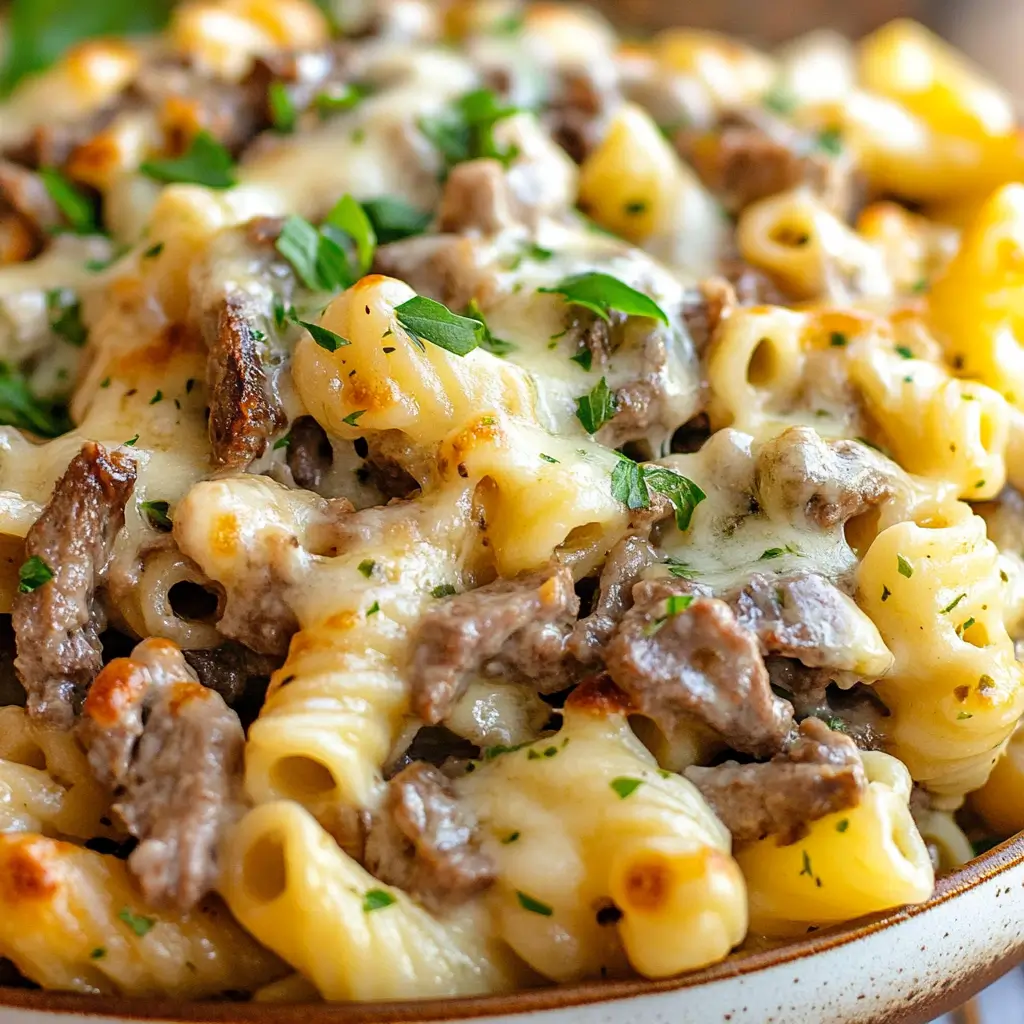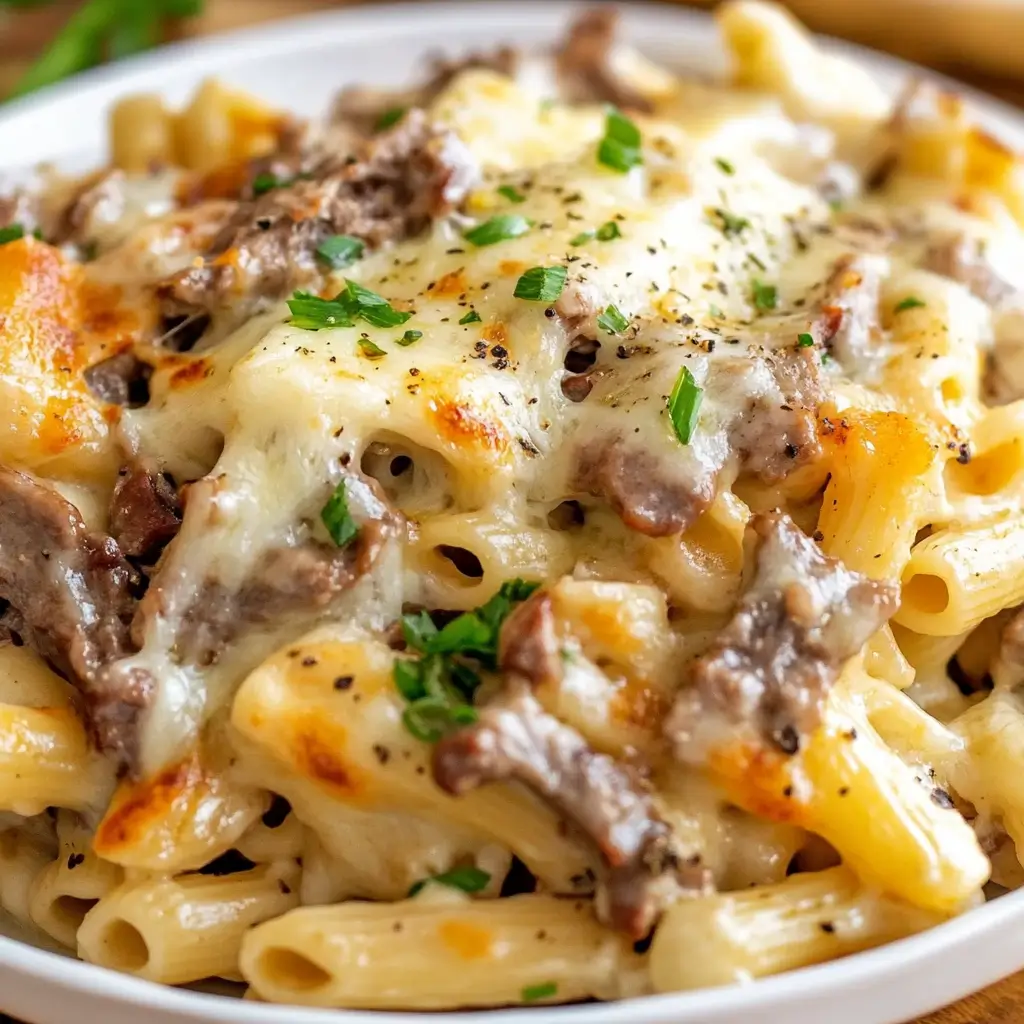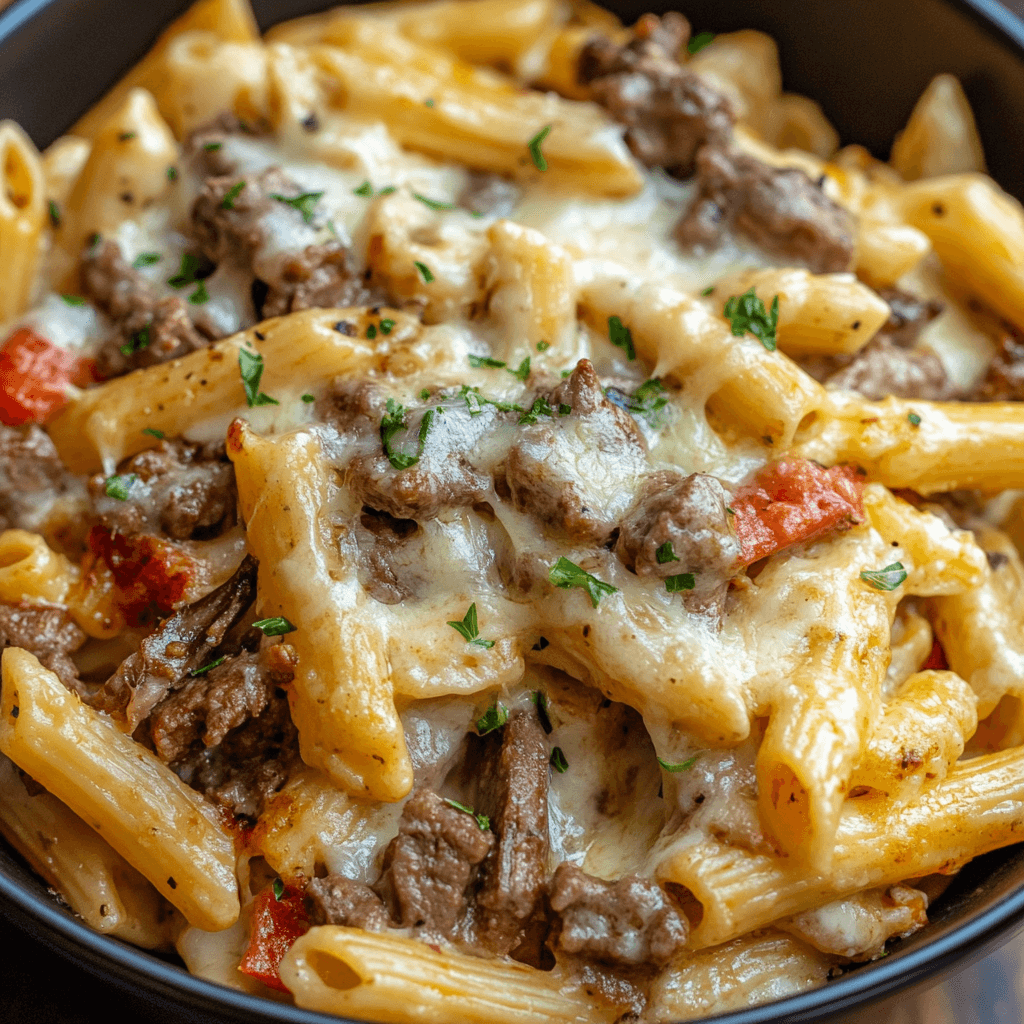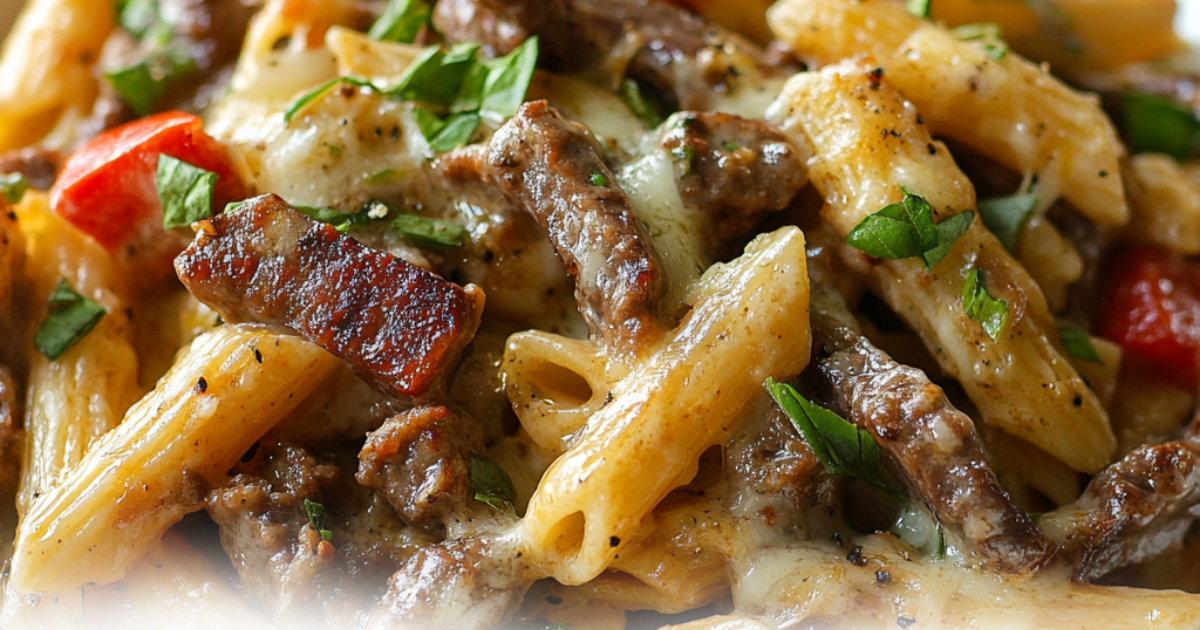Philly cheesesteak pasta emerges as a creative twist on two beloved classics. It merges the rich, meaty flavor of Philly cheesesteak with the creamy, comforting texture of pasta. This dish appeals widely, yet many wonder about its nutritional profile. Specifically, how many calories are in Philly cheesesteak pasta? In this exploration, we will address that question comprehensively.
Table of contents
Exploring the Ingredients Behind the Flavor
The primary components of Philly cheesesteak pasta include thinly sliced steak, onions, peppers, mushrooms, cheese, and pasta. Typically, the type of pasta used can vary, although penne or fusilli are common choices because they hold sauce well. The dish is often enriched with a creamy cheese sauce, which contributes significantly to the total caloric count. Below, we’ll detail each ingredient’s role and how it contributes to the dish’s overall calorie content.
- Steak: Provides the bulk of protein but also considerable fat, depending on the cut.
- Onions and Peppers: Add flavor with minimal calories.
- Mushrooms: Offer a meaty texture with few calories.
- Cheese: Increases calorie content substantially, particularly if high-fat varieties are used.
- Pasta: Serves as a high-carbohydrate base, significantly impacting the calorie count.

Average Caloric Content of Philly cheesesteak Pasta
A typical serving of Philly cheesesteak pasta contains between 700 to 900 calories. The variation largely depends on the type and amount of cheese and meat used, as well as the serving size. This caloric content makes it a substantial meal option that could potentially cover a significant portion of an individual’s daily caloric intake, especially if one is maintaining a standard 2000-calorie diet.

For healthier ingredient swaps, explore creative ways to lower calories in classic dishes.
Nutritional Breakdown of Philly cheesesteak Pasta
Analyzing the nutritional content, Philly cheesesteak pasta is rich in proteins and fats, primarily from the steak and cheese. The pasta contributes a high carbohydrate count, which can be complex or simple carbohydrates based on the type of pasta chosen. Here is a closer look at what a typical serving might contain:
- Protein: Essential for muscle repair and growth.
- Fats: Provides energy; however, the type of fat (saturated vs. unsaturated) is crucial for health.
- Carbohydrates: Serve as the body’s main energy source.
Impact of Cooking Techniques on Caloric Content
The way Philly cheesesteak pasta is prepared can greatly affect its caloric content. For example, sautéing the steak and vegetables in large amounts of oil or butter can increase the fat content, whereas using a non-stick spray or broth can reduce it. Additionally, the choice between a cream-based or a tomato-based sauce can also dramatically alter the calorie count.

How many calories are in Philly cheesesteak pasta? Comparison with Other Popular Pasta Dishes
When compared to other popular pasta dishes, Philly cheesesteak pasta is generally higher in calories. For instance, a serving of spaghetti Bolognese might contain around 560 calories, while a creamy fettuccine Alfredo could range up to 1200 calories. The high protein and fat content in Philly cheesesteak pasta contribute to its higher caloric value, making it more calorie-dense than many tomato-based pasta dishes.
How many calories are in Philly cheesesteak pasta? Health Implications of Frequent Consumption
Regular consumption of high-calorie meals like Philly cheesesteak pasta can lead to weight gain if not balanced with physical activity or other lower-calorie meals. Additionally, the high saturated fat content, primarily from the cheese and certain cuts of steak, can increase the risk of heart disease if consumed excessively.
How many calories are in Philly cheesesteak pasta? Guidelines for Portion Control
Managing portion sizes is crucial for enjoying Philly cheesesteak pasta as part of a balanced diet. Here are some tips for portion control:
- Use a smaller plate to help visually reduce portion sizes without feeling deprived.
- Balance the meal with a side of vegetables to increase fullness and nutrient intake.
- Consider using leaner cuts of meat and low-fat cheese options to reduce the overall caloric content.
By understanding the caloric content and nutritional impact of Philly cheesesteak pasta, individuals can make informed decisions about incorporating this dish into their diets in a health-conscious way.
Low-Calorie Alternatives for Ingredients
When considering how many calories are in Philly cheesesteak pasta, substituting certain ingredients can significantly reduce the calorie count. Firstly, opting for lean cuts of beef, such as top sirloin, helps decrease fat content. Secondly, whole-wheat pasta or zucchini noodles offer a healthier base with fewer carbohydrates. Additionally, using skimmed cheese or a plant-based cheese alternative adds flavor without excessive calories.
- Meat: Switch to leaner cuts or use ground turkey.
- Pasta: Choose whole grain or vegetable noodles.
- Cheese: Opt for low-fat or vegan cheese.
How to Make Philly Cheesesteak Pasta Healthier
To make Philly cheesesteak pasta healthier, focus on balancing the dish with more vegetables and controlling portion sizes. Adding bell peppers, onions, and mushrooms increases the volume and nutrient content without adding many calories. Furthermore, preparing the sauce with Greek yogurt instead of cream maintains a creamy texture while reducing fat. This approach not only lowers the overall calories but also enhances the dish’s nutritional profile.

Expert Insights on Philly Cheesesteak Pasta
Experts suggest that the key to enjoying Philly cheesesteak pasta lies in moderation and ingredient choice. For instance, selecting quality beef enhances flavor, allowing for smaller portions while still satisfying taste buds. Additionally, chefs recommend sautéing vegetables in olive oil instead of butter for a heart-healthier option. These expert tips ensure the dish remains a delightful part of a balanced diet.
Dietary Considerations for Philly Cheesesteak Pasta
This dish offers various adaptations to cater to different dietary needs. For gluten-sensitive individuals, gluten-free pasta is a suitable substitute that does not compromise the texture or taste. Likewise, for those avoiding red meat, chicken or plant-based steak strips can be excellent alternatives. Each variation still captures the essence of the classic Philly cheesesteak flavor while accommodating dietary restrictions.
FAQs about Philly Cheesesteak Pasta
Can I prepare Philly Cheesesteak Pasta ahead of time?
Yes, you can! Cook the pasta and prepare the cheesesteak mixture separately. Store them in airtight containers in the refrigerator. Combine and reheat before serving for the best flavor.
What type of pasta works best for this dish?
Short pasta like penne, rigatoni, or rotini works best as they hold the sauce well. However, you can use any pasta you prefer.
Can I freeze Philly Cheesesteak Pasta?
Yes, you can freeze it. Store it in a freezer-safe container for up to 3 months. Reheat in a skillet or microwave, adding a splash of milk or broth to refresh the sauce.
What kind of cheese should I use?
Traditional Philly cheesesteak uses provolone or American cheese. You can also try mozzarella or cheddar for a twist.
How can I make this dish spicier?
Add sliced jalapeños, crushed red pepper flakes, or a dash of hot sauce to give the dish a spicy kick.
What is the best type of steak to use?
Ribeye is ideal for its tenderness and flavor, but sirloin or flank steak are also great options. Thinly slice the steak for the best texture.
Can I add vegetables to this dish?
Certainly! Bell peppers, mushrooms, and onions are traditional Philly cheesesteak additions. You can also incorporate spinach, zucchini, or broccoli for extra nutrition.
Can I use ground beef instead of steak?
Yes, ground beef is a budget-friendly and convenient alternative. Cook it thoroughly and season it with steak spices for a similar flavor profile.
What are some suitable side dishes for Philly Cheesesteak Pasta?
Garlic bread, a simple green salad, or roasted vegetables pair wonderfully with this dish. For a heartier meal, try serving it with a bowl of tomato soup or corn on the cob.
Recipe Variations and Regional Differences
Philly cheesesteak pasta varies significantly by region. In Philadelphia, the dish might include more traditional elements like Provolone cheese, while a Californian version might incorporate elements like avocado or sun-dried tomatoes to reflect local tastes. These variations allow the dish to resonate with local flavor preferences while maintaining its universal appeal.
The Role of Philly Cheesesteak Pasta in American Cuisine
Philly cheesesteak pasta is more than just a meal; it’s a cultural phenomenon that reflects America’s melting pot nature. This dish creatively combines elements from Italian-American cuisine, with its love for pasta and creamy sauces, and traditional Philadelphia cuisine, known for its iconic cheesesteak. The result is a fusion that feels both familiar and innovative, offering a comforting blend of flavors that appeals to diverse palates.
Its role in American cuisine extends beyond taste—it’s a symbol of culinary adaptability and the blending of regional and ethnic influences that define the nation’s food culture. Whether enjoyed at a family dinner, a potluck, or even a casual restaurant, Philly cheesesteak pasta embodies the essence of comfort food: hearty, satisfying, and nostalgic.
Additionally, its versatility allows for endless customization, from swapping out traditional ingredients to accommodating dietary preferences, further solidifying its place as a staple in American households. It’s a dish that invites creativity while staying rooted in the flavors and traditions that make it a beloved classic.
Future Trends in Pasta Dishes Like Philly Cheesesteak Pasta
Looking ahead, pasta dishes like Philly cheesesteak pasta will likely continue to evolve. Anticipated trends include an increase in plant-based options and the incorporation of global flavors to cater to diverse palates. As dietary preferences shift towards more health-conscious choices, these adaptations will ensure that pasta dishes remain a staple in American dining while also aligning with modern eating habits.

